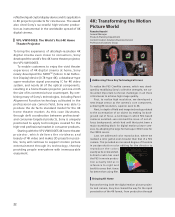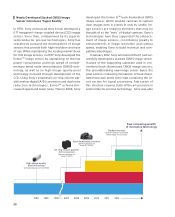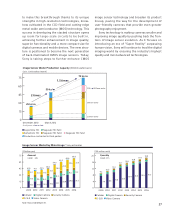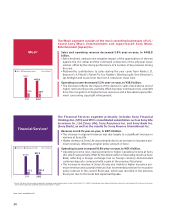Sony 2012 Annual Report Download - page 31
Download and view the complete annual report
Please find page 31 of the 2012 Sony annual report below. You can navigate through the pages in the report by either clicking on the pages listed below, or by using the keyword search tool below to find specific information within the annual report.
Developing the Stacked CMOS Image Sensor
The principal theme guiding our eorts is the desire of
people to be able to shoot photographs and video that
create vivid memories that bring the viewer back to the
time and place depicted. To accomplish this, you need a
camera that delivers the resolution, sensitivity and color
necessary to faithfully capture images.
In developing the stacked CMOS image sensor, we
sought to realize advanced functionality and compactness,
thus responding to the needs of a wide variety of applica-
tions that are likely to be developed in the future. I expect
the stacked CMOS image sensor to gain popularity as a
next-generation back-illuminated CMOS image sensor, but,
more importantly, I believe that we have taken a step closer
to a world where we can reproduce memories so vividly
that you feel like you are actually there.
Sony’s Strengths in the Image Sensor Market
Going back to our first CCD image sensor, our ability
to constantly innovate in image sensor development
has been underpinned by our unwavering pursuit
of high image quality, as well as by cutting-edge
MOS technology accumulated in the development
of LSIs for audio and video products and game
consoles.
The manufacturing process for stacked CMOS
image sensors requires an extremely high level of
precision in the positioning of semiconductor layers.
To get an idea of the precision involved, imagine
an area the size of a baseball stadium: you need
technology that can place an object as minute as a
few strands of hair in exactly the right position.
Sony has an absolute commitment to delivering
superb image quality, as well as top-class technical
capabilities. These two attributes are what have
enabled us to remain a leader in the image sensor
market.
On the Frontlines of Development
Sony’s electronics business encompasses products for
consumers and products for professional users. In the
Image Sensor Business Division, incorporating valuable
insights from both of these domains into our develop-
ment process enables us to cultivate unique strengths.
As we introduce “Super Reality,” which surpasses
human vision, we are also looking ahead to identify
new potential in the area of image sensors. It is in our
Sony DNA to never give up. If we discover something
truly exciting—something that makes us shout “This is
it!”—we keep going until we’ve finished what we set
out to do. This was true for the stacked CMOS image
sensor, which we were able to develop ahead of our
competitors because we believed that it was the key to
future innovation.
We will continue to contribute to the advancement
of digital imaging by developing technologies that will
allow us to bring excitement and enjoyment to as
many people as possible.
Tetsuo Nomoto
General Manager
Business Department 2, Image Sensor Business Division
Semiconductor Business Group
Sony Technology Drives the
Evolution of Digital Imaging
29
























